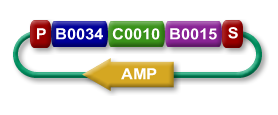Difference between revisions of "An Introduction to BioBricks"
Jamesbrown (Talk | contribs) (→Designing BioBrick Devices & Systems: Tools & Methods) |
Jamesbrown (Talk | contribs) (→Methods & Guides) |
||
| Line 39: | Line 39: | ||
{| | {| | ||
|valign='top'| | |valign='top'| | ||
| − | |||
*[[Help: How to make a BioBrick|How to make a BioBrick]] | *[[Help: How to make a BioBrick|How to make a BioBrick]] | ||
*[http://openwetware.org/wiki/BioBricks_construction_tutorial How to perform a construction] | *[http://openwetware.org/wiki/BioBricks_construction_tutorial How to perform a construction] | ||
*[[Help:Standardization|Standardization of non-Biobrick sequence]] | *[[Help:Standardization|Standardization of non-Biobrick sequence]] | ||
|valign='top'| | |valign='top'| | ||
| + | |||
===Tools=== | ===Tools=== | ||
*[[Add_a_Part_to_the_Registry | Add a part to the Registry]] | *[[Add_a_Part_to_the_Registry | Add a part to the Registry]] | ||
Revision as of 16:21, 14 July 2006

|
BioBricks are a set of interchangable parts, designed with a view to building biological systems in living cells. The picture to the left shows BioBrick part BBa_0034 within a plasmid. The brick is flanked by a standard biobrick prefix (P) and suffix (S). The yellow arrow represents the plasmid's antibiotic resistance gene and the green arrow, its origin of replication. Click the image to find out more or alternatively see: |
Building BioBrick Systems

|
BioBrick parts can be assembled to form useful devices, through a process often refeed to as 'Standard Assembly' This uses normal cloning techniques based on restriction enzymes, purification, ligation, and transformation. BioBrick parts are composable; allowing endless numbers of biobricks to be pieced together to form higher systems. The assembly to the left shows 3 BioBricks assembled to create a simple device. You can learn more about this device by following the link to its associated page in the registry. You may like look into:
|
Designing BioBrick Devices & Systems: Tools & Methods

|
The Registry provides several tools that will aid you in designing and understanding biobrick systems and devices. Adding a part to the Registry allows you to quickly and easily manipulate new designs. The 3 part search facility allows you to quickly and easily scour the registry for information, trace the origin of more complex parts and see which higher systems have been constructed with any part of choice. Having designed your biobricks using the extensive regitry tool set, you'll want to physically make your biobrick; the online help system gives definitive guides to protocols and procedures relating to this topic, see:
|


